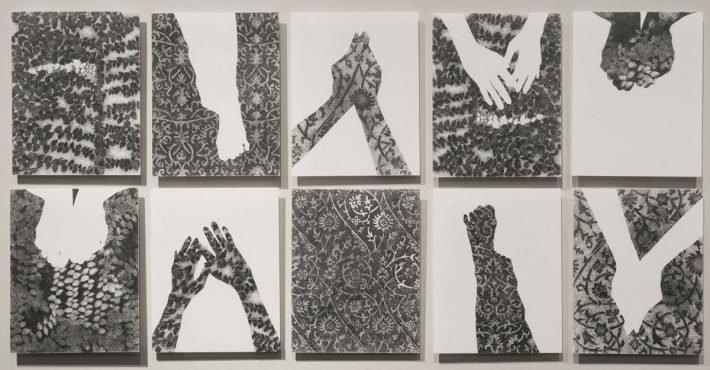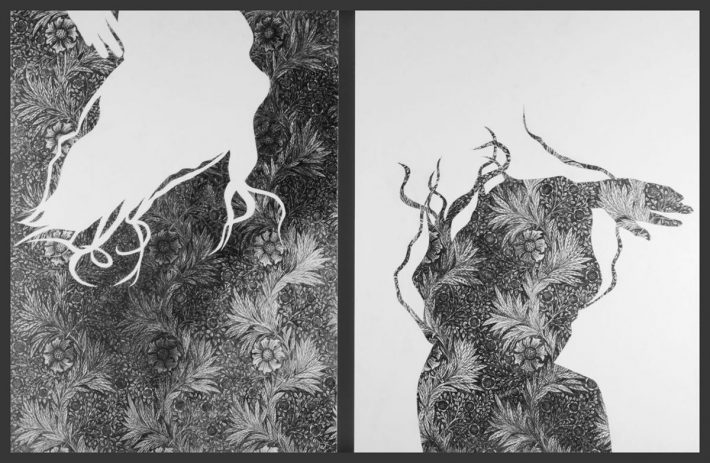by Sarah Bonnette for The Times-Picayune | New Orleans Advocate

For New Orleans artist Mary Jane Parker, there’s something soothing about drawing.
“I think it’s a little bit like meditation or mindfulness in a way,” she said. “I’ve realized when I’ve gone through any kind of long stretches of not making work, when I finally put my hand on a piece of chalk or a brush or a pencil or something like that, there’s something in me that just becomes quiet.”
While Parker creates artwork in multiple media — mostly encaustic paintings, along with mixed media, bronze sculptures and archival pigment prints, — “Drawing is the foundation that all of my work is built on,” she said in a statement for “A Partial View,” an exhibition of her work opening Oct. 10 at the St. Tammany Art Association.

The opening will be part of Fall for Art, an annual celebration of the arts presented by STAA. This year’s event — presented on a smaller scale because of COVID-19 crowd restrictions — will include more than a dozen downtown Covington galleries, shops and restaurants showcasing artists.
A native New Orleanian, Parker’s path to becoming an artist began in high school. “That’s when I became fairly serious about it,” she said, earning a Bachelor of Fine Art degree from LSU and a Master of Fine Art degree, with an emphasis in printmaking, from Illinois State University.
Parker has exhibited her artwork nationally and internationally with acclaim, having received two Louisiana Division of the Arts Individual Artist Fellowships and a National Endowment for the Arts/Southern Arts Federation Award for Excellence in Works on Paper. Additional fellowships allowed her to travel along the pilgrimage route in France and Spain and study color woodcut in Florence, Italy.
Parker is represented by Arthur Roger Gallery and has shown at the New Orleans Museum of Art and the Contemporary Arts Center. When not creating her own artwork, she serves as the chairwoman of the New Orleans Center for Creative Art’s visual arts department and is a member of NOCCA’s teaching faculty.

While “A Partial View” will include some of Parker’s glasswork featuring figurative elements, most of the approximately 28 pieces will be Parker’s drawings. She often uses graphite to create elaborate details.
On display will be pieces from the “Vocabulary Series,” a body of work based on Parker’s interest in hysteria. Women in the early 1900s often were diagnosed with the disease.
“There are many theories about exactly what hysteria was and why it predominantly afflicted women. The aspect of the disease that has most fascinated me, however, is how the medical professionals used it to restrict women who did not follow the rules and expectations of society,” Parker said in the show’s statement.
Parker’s interest in the subject began with “an anthology of literature based on the concepts of hysteria, and it had a lot of historical information in it,” she said, adding that the book also contained drawings by Dr. Jean-Martin Charcot, a mentor to Dr. Sigmund Freud.
“He would go at night and watch the hysterical women in the hospital in Paris and would draw them as they woke up and had their sort of seizures. He created a chart with all the drawings on it,” Parker said, adding that his chart inspired “Sky Charts,” an installation at the Contemporary Arts Center, and “Skywatching,” an exhibition at Arthur Roger Gallery.
The “Vocabulary Series” features small pieces where Parker has “intricately drawn patterns to suggest wallpaper, embroidery or domestic crafts. Against these lovely, quiet backgrounds, I juxtapose a figure or part of the body in a tense or distressed pose with hair in disarray or toes flexed.
“One important aspect of the work is the obsessive nature of the act of drawing, using a 2B pencil to describe every detail. The tedious act of drawing in this way mimics the restrictive time spent on domestic crafts in the 1800s,” she said on her website, http://maryjaneparkerart.com.
For the most part, Parker drew the series on Yupo, an erasable, nonporous paper made from polypropylene. It was originally made for watercolor paintings.
“I just started playing with pencils — just mechanical pencils, really — drawing on it,” Parker said, comparing the paper with the lithographic stones she used to draw on during her printmaking days.
“What I love about it — I use the translucent one — is it looks a little bit like skin,” Parker said. “It has this really lovely kind of velum quality about it, but it’s got a little bit more depth to it. It’s really lovely to draw on as far as graphite goes.”
